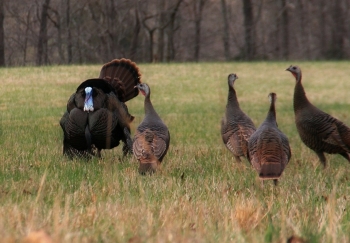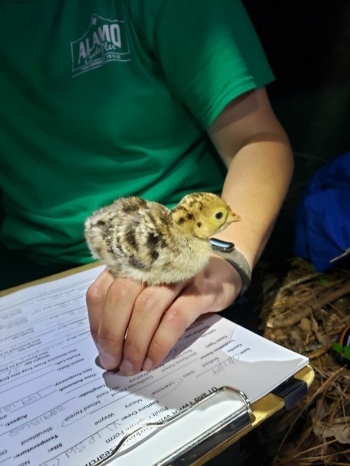One Little, Two Little, Three Little Turkeys: How You Can Help Biologists Count Turkeys for Management
I saw my first wild turkeys when I was between college semesters and back at my parent's home in rural Kansas. The large, lanky birds were silently moving single-file along the brushy fence line separating our hayfield from the cattle pasture. I didn’t know much about turkeys at that time, but I knew enough to realize it was pretty unusual to see turkeys on the property because I understood turkeys needed more woodland than the prairie landscape surrounding my parents’ home. Where they came from and where they were going is anyone’s guess, but seeing them that day may have set in motion the course of my entire career. For in only a few short weeks, I began my graduate program in wildlife management at South Dakota State University studying none else but wild turkeys. I’ve been studying and working with wild turkeys ever since.
Over the years since that first encounter, I’ve seen many dozens, if not hundreds, of wild turkeys. I’ve captured and relocated turkeys for research and restoration purposes; fitted them with leg bands and radio transmitters to aid our study efforts; even hunted them and been blessed on a few occasions with a successful harvest that my family and I enjoyed around the dinner table. And still, every time I see a wild turkey, I am struck by the experience. I appreciate their uniqueness, even their quirkiness at times. I consider myself fortunate every time I see one.
Apparently, I’m not the only one who enjoys seeing wild turkeys. Very often when I meet somebody new and they learn that I work for the wildlife agency managing wild turkeys, the person wants to tell me about their latest wild turkey sighting. Several of my friends from outside the wildlife profession still report to me whenever they happen to spot a turkey. There’s just something about these creatures that capture our attention.
As simple as it may sound, seeing turkeys is a significant part of managing the state’s wild turkey resource. Every summer, Tennessee Wildlife Resources Agency (TWRA) staff, along with a few natural resource professionals from other agencies, record observations of wild turkeys and their young made during their regular fieldwork activities. Records of wild turkey sightings provide the agency with information on many factors that influence turkey population trends, including nesting success, brood survival, and overall annual reproductive success. The number of young produced each year is generally the primary factor influencing wild turkey population trends, so knowing this information is important to sound turkey management. Through the survey, we also obtain information on peak hatching dates of turkey broods and carry-over of males from the spring hunting season.
Summer survey data have been collected in Tennessee for nearly 40 years, dating back to the early years of turkey restoration efforts here. Although it’s hard to believe now, from the early 1900s to the 1980s, wild turkeys were a rarity in Tennessee, likely the result of decades of habitat modification and unregulated hunting. Through intensive restoration efforts by TWRA and conservation partners—which involved trapping birds where they were still plentiful and moving them to new areas with good habitats—by the turn of the century wild turkey populations were re-established throughout Tennessee.
Even though turkeys occur across the state now, the summer survey data TWRA staff collect is incomplete for much of the state. There simply are not many staff members in some parts of the state, so we obtain very few observations for these areas and, as a result, we have little knowledge of turkey production in these areas. Consequently, TWRA is inviting everybody to take part in the summer turkey observation survey. For those who enjoy seeing wild turkeys and want to be a part of the science of turkey management, this is a wonderful opportunity to get involved.

One of the most challenging aspects of the summer surveys is accurately determining what you’re seeing. Usually, turkeys are seen in groups and the tendency of observers is to get caught up in the excitement of seeing a flock of turkeys and not pay close attention to what kind of turkeys they are seeing or accurately count all the turkeys in the group. It’s critical for observers to take time and really focus on a few specifics. We encourage observers to use binoculars, if they can, to get a good look at the turkeys. If you’re driving, pull over to the side of the road if conditions permit. The things to focus on are the number and sex of the birds seen, and the age of any poults (baby turkeys) observed. To help with this task, it’s good to learn a little bit about turkey behavior along with some physical characteristics.
Flock structure. During the summer, turkeys typically separate into specific flocks. Because male turkeys (called gobblers) are not involved in rearing the young, they usually hang out with other males in what are called bachelor groups, away from the females. Gobblers are most easily distinguished from female turkeys by a tuft of modified feathers—its “beard”—protruding from their chest just below the neck. In older, mature gobblers, the beard can be as much as 7-9 inches or more in length whereas younger gobblers, known as jakes, have beards less than 6 inches long. However, occasionally hens have beards too (about 5-10 percent of hens do), so you can’t completely rely on seeing (or not seeing) a beard to determine turkey sex. Gobblers are also recognized by their larger, darker appearance, often showing brilliant iridescence in the feathers, and by their redder-colored heads.
Females that did not nest, or that nested unsuccessfully, will get together with other unsuccessful hens. Groups of unsuccessful hens can number from just two or three to over a dozen or more. Lastly, there are groups of turkeys composed of one or more successful hens and their brood of young turkeys. When the poults are very young, a brood hen will usually stay away from other hens. As the poults get older, hens will frequently group up with other brooding hens. Often, in combined brood flocks there are poults of different ages running around together.
Brood age. Survey participants are asked to determine which of three age classes observed poults fit into. With combined brood flocks, more than one age class may be represented. Age-class 1 poults are newly hatched (no more than a week old). Poults at this stage are down-cover, flightless little “puff-balls” no bigger than your fist.
Age-class 2 poults are 2-5 weeks old and are about 6-10 inches tall. At this stage, the wings have grown new feathers and the poults are able to make short, bounding flights that get farther and stronger as the poults age. Because the wings are the only body part to have been replaced down with larger new feathers, poults in this age class often appear to be all wings.
Lastly, poults in age-class 3 are 6-8 weeks and older. They range from about the size of a chicken to almost as big as the brood hen by late in the summer. Because they are very similar in size, late in the summer it can be very challenging to determine if a group of similar-sized turkeys is a flock of unsuccessful hens or a hen and her older-age-class brood, but with careful observation, one can usually note slight size differences in the case of an older brood. However, if you are unsure, it’s best to just mark the observation as unknown.
The survey runs from June 1 through the end of August every summer. So, if you’re like me and find turkeys fascinating to observe and you’d enjoy participating in the survey, please visit the survey page so you can take part.



